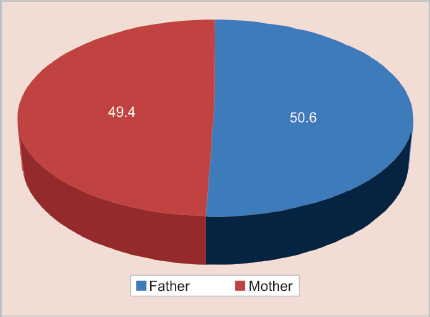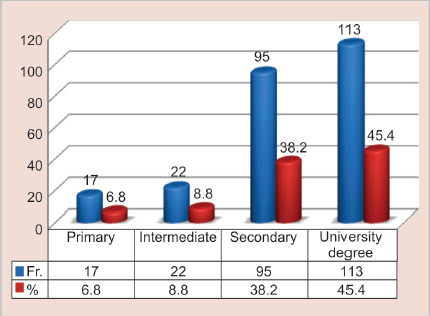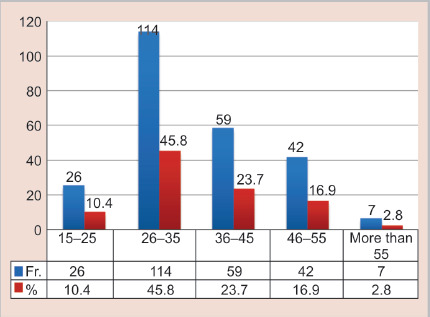Abstract
Introduction
Two main factors have a great influence on the youth's oral well-being. These are their dental health and age. These two factors are significantly directed by parents through establishing a system of proper oral hygiene and a preventative routine for those young adults.
Aim and objective
The following study was run in the Dammam region, Saudi Arabia, to assess guardian awareness of youngster's dental health.
Materials and methods
This community-based study was designed in a cross-sectional pattern, where a sample size of 248 parents who fulfilled inclusion criteria was selected and a well-designed validated questionnaire was used for the collected database using SPSS (VER. 24).
Results
The main found included that, about 51% of participants were fathers and 49% were mothers, 90% of them above the age of 26 years old and most of the participants had a secondary certificate or university degree, 38% and 45%, respectively, only 64% of parents have checked their children teeth, the average of overall knowledge of parents toward dental health was medium 7.97 points out of 16.0 points and there was a statistically significant relationship between parents type, educational level, and overall knowledge related to oral health.
Conclusion
From our study, it was acknowledged that the perception of children's oral health status by their parents in the Dammam region is relatively medium, so general awareness of parents’ knowledge should be raised by conducting effective oral health programs and interventions.
How to cite this article
Alshammari FS, Alshammari RA, Alshammari MH, et al. Parental Awareness and Knowledge toward their Children's Oral Health in the City of Dammam, Saudi Arabia. Int J Clin Pediatr Dent 2021;14(1):100–103.
Keywords: Dammam region, Dental health, Parental awareness, Saudi Arabia
Introduction
Dental complications, including caries, are mainly controlled by the level of oral hygiene.1,2 It has previously been proven that untreated dental caries promotes painful experiences which may lead to emergency visits, premature tooth loss resulting in altered chewing, as well as defacement and destruction to the permeant dentition in youngsters.3 Therefore, the need for enriched oral hygiene from early childhood is of great importance to render the above-listed issues. The American Academy of Pediatric Dentistry (AAPD) has recommended dental brushing using a soft toothbrush of age-appropriate size to be performed two times a day.4 The academy has also stated that it is the guardian's responsibility to perform this procedure if their children are still not dependent.5 Thus, it is of great importance to highlight the significance of establishing parent awareness for children's dental needs as this will decrease future oral health issues.
It has been recently noticed that a large number of parents do not give enough attention to their children's oral health status and assume that their brushing is of an appropriate level.6 Children of this specific group tend to brush their teeth without adult supervision,7,8 others, unfortunately, skip the brushing habit as their parents do not show any obligations for it9–11 and do not believe in regular dental checkups before permanent teeth erupt,12 unless pain is present.12 This neglection enforces the need for awareness spread toward enhanced dental oral hygiene and preventative acts.
Study Objectives
General Objective
This study targets the evaluation of parent awareness in relation to the dental health of children in Dammam City, Saudi Arabia.
Specific Objectives
To assess parents’ knowledge related to dental problems among children.
To identify the parents’ first dental visit.
To demonstrate parents’ source of dental health information.
To compare if there is a statistically significant difference between parents type, age group, educational level, monthly income, and the overall knowledge related to oral health.
Methods and Subjects
Study Design
This community-based cross-sectional study was conducted at Dammam city from September to December 2019 to assess guardian awareness of youngsters’ dental health.
Study Population
Parents in the Dammam region who fulfilled inclusion criteria.
Study Samples
For this study, a sample size of 248 parents was selected by using the simple random samples technique.
Inclusion Criteria
The one who consented to the study.
One who had at least one child.
Exclusion Criteria
The one who was not willing to participate.
Who does not have any children.
Data Collection Tools
Data were collected by using well developed validated questionnaire that covered independent variables such as demographic variables and other dependent variables related to children's oral health.
Statistical Analysis
The statistical analysis was applied by employing the Statistical Package of Social Science (SPSS), version 24 where both descriptive and analytical statistics were conducted, these different statistical tools involved; mean and standard deviation (SD) for quantitative variables, frequencies, and percentage for qualitative variables while one-way ANOVA and independents t-test were used to compare if there was a statistically significant difference between independent variables and parents overall knowledge related to child oral health.
Ethical Consent
All ethical issues were considered during the process of this study and the study proposal was approved by Dammam university ethical committee and the consent form was filled by participants before starting the study.
Results (Tables 1 to 7 and Figs 1 to 3)
Table 1.
Demographic characteristic of the participants (N = 249)
| Variable | Sub-variable | Fr. | % |
|---|---|---|---|
| Parents type | Father | 126 | 50.6 |
| Mother | 123 | 49.4 | |
| Age group in years | 15–25 | 26 | 10.4 |
| 26–35 | 114 | 45.8 | |
| 36–45 | 59 | 23.7 | |
| 46–55 | 42 | 16.9 | |
| >55 | 7 | 2.8 | |
| Educational level | Primary | 17 | 6.8 |
| Intermediate | 22 | 8.8 | |
| Secondary | 95 | 38.2 | |
| University degree | 113 | 45.4 | |
| Missing | 2 | 0.8 | |
| Marital state | Married | 223 | 89.6 |
| Divorce | 4 | 1.6 | |
| Other | 21 | 8.4 | |
| Missing | 1 | 0.4 | |
| Monthly income level | Low | 13 | 5.2 |
| Medium | 200 | 80.3 | |
| High | 30 | 12.0 | |
| Missing | 6 | 2.4 |
51% of participants were fathers and 49.9% were mothers, 90% of participants above the age of 26 years old, and 82% had a university degree, about 72% of participants above the age of 35 years old. Most of the participants had a secondary certificate or university degree 38 and 45%, respectively, majority 90% were married and about 80% medium monthly income level
Table 7.
One-way ANOVA to compare between a number of children and overall knowledge of participants related to oral health
| Number of children | N | Mean | Std. deviation | 95% confidence interval for mean | p value | |
|---|---|---|---|---|---|---|
| Lower bound | Upper bound | |||||
| One | 37 | 7.46 | 2.280 | 6.70 | 8.22 | 0.54 |
| Two | 44 | 8.02 | 2.520 | 7.26 | 8.79 | |
| Three | 48 | 8.38 | 3.272 | 7.42 | 9.33 | |
| >3 | 99 | 7.98 | 2.990 | 7.38 | 8.58 | |
| Total | 228 | 7.99 | 2.860 | 7.61 | 8.36 | |
There was a negative statistical significance between the number of children and the overall knowledge of participants. p value >0.05
Fig. 1.

Parents type: About 51% of participants were fathers and 49% were mothers
Fig. 3.

Educational level: 82% had a university degree
Table 2.
Parents opinion related to checking children tooth, their first dental visit, and source of dental health information
| Variable | Sub-variable | Fr. | % |
|---|---|---|---|
| Do you ever check your children teeth? | Yes | 159 | 63.9 |
| No | 76 | 30.5 | |
| I’m not sure | 12 | 4.8 | |
| Where did you receive your dental health information? | Dentist | 109 | 43.8 |
| Television | 54 | 21.7 | |
| Family members | 54 | 21.7 | |
| When should babies have their first dental visit? | When tooth erupts | 33 | 13.3 |
| After 1 year | 94 | 37.8 | |
| I don’t know | 113 | 45.4 |
64% of participants have checked their children teeth, 44% of participants receive dental health information from the dentist, while only 38% visited the dentist after 1 year
Table 3.
One-way ANOVA to compare between parents’ gender and overall knowledge of participants related to oral health (N = 249)
| Parents type | N | Mean | Std. deviation | 95% confidence interval for mean | p value | |
|---|---|---|---|---|---|---|
| Lower bound | Upper bound | |||||
| Father | 126 | 7.29 | 2.692 | 6.81 | 7.76 | 0.000 |
| Mother | 122 | 8.68 | 2.826 | 8.17 | 9.19 | |
| Total | 248 | 7.97 | 2.840 | 7.62 | 8.33 | |
There was a statistically significant relationship between parents’ gender and overall knowledge of participants related to oral health, mothers were more aware than fathers related to children's dental health. p value <0.05. The average overall knowledge of parents toward dental health was medium 7.97 out of 16.0 points
Table 4.
One-way ANOVA to compare between age-group and overall knowledge of participants related to oral health
| N | Mean | Std. deviation | 95% confidence interval for mean | p value | ||
|---|---|---|---|---|---|---|
| Lower bound | Upper bound | |||||
| 15–25 | 26 | 7.77 | 2.790 | 6.64 | 8.90 | 0.36 |
| 26–35 | 114 | 7.85 | 2.556 | 7.38 | 8.33 | |
| 36–45 | 59 | 8.32 | 2.979 | 7.55 | 9.10 | |
| 46–55 | 42 | 7.79 | 3.531 | 6.69 | 8.89 | |
| > 55 | 7 | 8.86 | 1.676 | 7.31 | 10.41 | |
| Total | 248 | 7.97 | 2.840 | 7.62 | 8.33 | |
There was no statistically significant relationship between age-group and overall participants’ knowledge of oral health. p value >0.05
Table 5.
One-way ANOVA to compare between educational level and overall knowledge of participants related to oral health
| Educational level | N | Mean | Std. deviation | 95% confidence interval for mean | p value | |
|---|---|---|---|---|---|---|
| Lower bound | Upper bound | |||||
| Primary | 17 | 6.88 | 3.839 | 4.91 | 8.86 | 0.03 |
| Intermediate | 22 | 7.32 | 2.750 | 6.10 | 8.54 | |
| Secondary | 95 | 7.82 | 2.817 | 7.25 | 8.39 | |
| University degree | 113 | 8.43 | 2.625 | 7.94 | 8.92 | |
| Total | 247 | 7.99 | 2.828 | 7.64 | 8.35 | |
There was a statistically significant relationship between the educational level and overall knowledge of participants related to oral health. p value <0.05, parents who had university degree were more aware of children oral health
Table 6.
One-way ANOVA to compare between income and overall knowledge of participants related to oral health
| Monthly income level | N | Mean | Std. deviation | 95% confidence interval for mean | p value | |
|---|---|---|---|---|---|---|
| Lower bound | Upper bound | |||||
| Low | 13 | 8.38 | 2.902 | 6.63 | 10.14 | 0.55 |
| Medium | 200 | 7.98 | 2.865 | 7.58 | 8.37 | |
| High | 30 | 8.20 | 2.265 | 7.35 | 9.05 | |
| Total | 243 | 8.02 | 2.792 | 7.67 | 8.38 | |
There was a negative statistical significance between monthly income level and participants’ overall knowledge. p value >0.05
Fig. 2.

Age-groups: 90% of participants above the age of 26 years old
Discussion
This community-based cross-sectional study was conducted at Dammam city from September to December 2019 to assess guardian awareness of their youngsters’ oral health. For this study, a sample size of 248 parents who fulfilled inclusion criteria was selected, about 51% of participants were fathers and 499% were mothers, 90% of participants above the age of 26 years old, and most of the participants had a secondary certificate or university degree 38% and 45%, respectively, majority 90% were married and about 80% medium monthly income level. A solid acknowledgment of parent understanding, together with their skills and perception, is essential for the promotion of oral health awareness in children. It has been proven that the positive parent attitude toward dental health, the healthful their child's oral status is.13
This present study indicated that 64% of parents were checked their children's teeth, 44% of them received dental health information from the dentist, while only 38% visited the dentist after 1 year and the average overall knowledge of parents toward dental health was medium 7.97 points out of 16.0 points. Many studies indicated that many parents had positive perceptions toward their children's dental health. However, it also reported a high percentage of mothers neglecting the importance of preserving primary dentition as they saw deciduous teeth as temporary and would be eventually replaced.14 Thus, early childhood caries did not create any threats to those mothers, which is a serious concern because dental caries holds a cumulative process and would affect those children later on throughout their lives.15 Untreated deciduous dental caries increases the risk of having permanent dentition caries which is accompanied by altered social self-esteem, and growth deficiencies.16
Also, the current study found that there was a statistically significant relationship between parents’ type, educational level, and overall knowledge related to oral health, mothers, and parents who hold university degrees were more aware related to children's dental health. These findings are matching to multiple studies which have successfully proven advanced mothers’ awareness and their unambiguous viewpoints regarding children's oral health through maintaining caries-friendly diet and constant toothbrushing. A correlation was located between high socioeconomic groups, well-educated families, and their appreciation of primary dentition importance.17,18 finally, our exploration has revealed negative statistical significance between age group, number of children, monthly income level, and overall knowledge related to oral health, these findings differed from one study conducted by Kim Seow.17
Conclusion
Based on our study, we have concluded that parents’ perception of their children's oral health in the Dammam region is relatively medium, so general awareness of parents’ knowledge should be raised by conducting effective oral health programs and interventions.
Footnotes
Source of support: Nil
Conflict of interest: None
References
- 1.Harris N, Garcia-Godoy F, Nielsen,, et al. 8th ed., New Jersey: Pearson; 2014. Primary preventive dentistry. [Google Scholar]
- 2.Newman M, Takei H, Klokkevold P, et al. 12th ed., Missouri: Elsevier; 2015. Carranza's clinical periodontology. [Google Scholar]
- 3.Kagihara LE, Niederhauser VP, Stark M. Assessment, management, and prevention of early childhood caries. J Am Acad Nurse Pract. 2009;21(1):1–10. doi: 10.1111/j.1745-7599.2008.00367.x. DOI: [DOI] [PubMed] [Google Scholar]
- 4.American Academy of Pediatric Dentistry. Pediatr Dent. 2008;30:40–43. American Academy of Pediatrics, American Academy of Pediatric Dentistry Council on Clinical Affairs. Policy on early childhood caries (ECC): classifications, consequences, and preventive strategies. [Google Scholar]
- 5.Skrīvele S, Care R, Bērziņa S, et al. Caries and its risk factors in young children in five different countries. Stomatologija. 2013;15(2):39–46. [PubMed] [Google Scholar]
- 6.Beal JF, Dickson S. Parental awareness of the dental needs of 5-year-old children in the West Midlands, England. Community Dent Oral Epidemiol. 1974;2(3):91–94. doi: 10.1111/j.1600-0528.1974.tb01664.x. DOI: [DOI] [PubMed] [Google Scholar]
- 7.Nuhu A, Sheikh Mohammad A, Naima N, et al. Evaluation of dental caries awareness among the parents of school going children in Dhaka city. Bangladesh Dental College J. 2011;2:21–26. [Google Scholar]
- 8.Chhabra N, Chhabra A. Parental knowledge, attitudes and cultural beliefs regarding oral health and dental care of preschool children in an Indian population: a quantitative study. Eur Arch Paediatr Dent. 2012;13(2):76–82. doi: 10.1007/BF03262848. DOI: [DOI] [PubMed] [Google Scholar]
- 9.Vanagas G, Milasauskiene Z, Grabauskas V, et al. Associations between parental skills and their attitudes toward importance to develop good oral hygiene skills in their children. Medicina (Kaunas) 2009;45(9):718–723. doi: 10.3390/medicina45090094. DOI: [DOI] [PubMed] [Google Scholar]
- 10.Saied-Moallemi Z, Virtanen J, Ghofranipour F, et al. Influence of mothers’ oral health knowledge and attitudes on their children's dental health. Eur Arch Paediatr Dent. 2008;9(2):79–83. doi: 10.1007/BF03262614. DOI: [DOI] [PubMed] [Google Scholar]
- 11.Al-Saad S, Al-Bokhamseen M, Al-Shalan T. Saudi parents’ knowledge about the importance of children's primary teeth and prevention of dental diseases in Al-Ahsa region, Saudi Arabia. Pak J Orthod Pediatr Community Dent. 2002;1:53–56. [Google Scholar]
- 12.Al-Shalan TA, Al-Musa BA, Al-Khamis AM. Parents’ attitude towards children's first dental visit in the college of dentistry, Riyadh, Saudi Arabia. Saudi Med J. 2002;23(9):1110–1114. [PubMed] [Google Scholar]
- 13.Schroth RJ, Brothwell DJ, Moffatt MEK. Caregiver knowledge and attitudes of preschool oral health and early childhood caries (ECC). Int J Circumpolar Health. 2007;66(2):153–167. doi: 10.3402/ijch.v66i2.18247. DOI: [DOI] [PubMed] [Google Scholar]
- 14.Azevedo MS, Romano AR, Dos Santos Ida S, et al. Knowledge and beliefs concerning early childhood caries from mothers of children ages zero to 12 months. Pediatr Dent. 2014;36:95–99. [PubMed] [Google Scholar]
- 15.Moimaz SA, Fadel CB, Lolli LF, et al. Social aspects of dental caries in the context of mother-child pairs. J Appl Oral Sci. 2014;22(1):73–78. doi: 10.1590/1678-775720130122. DOI: [DOI] [PMC free article] [PubMed] [Google Scholar]
- 16.Gao XL, Hsu CYS, Xu Y. Building caries risk assessment models for children. J Dent Res. 2010;89(6):637–643. doi: 10.1177/0022034510364489. DOI: [DOI] [PubMed] [Google Scholar]
- 17.Kim Seow W. Environmental, maternal, and child factors which contribute to early childhood caries: a unifying conceptual model. Int J Paediatr Dent. 2012;22(3):157–168. doi: 10.1111/j.1365-263X.2011.01186.x. DOI: [DOI] [PubMed] [Google Scholar]
- 18.Suresh BS, Ravishankar TL, Chaitra TR, et al. Mother's knowledge about pre-school child's oral health. J Indian Soc Pedod Prev Dent. 2010;28(4):282–287. doi: 10.4103/0970-4388.76159. DOI: [DOI] [PubMed] [Google Scholar]


